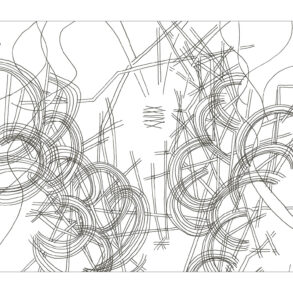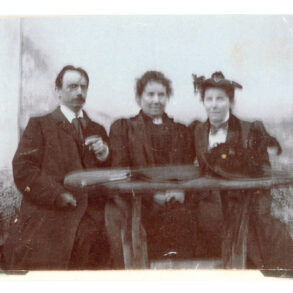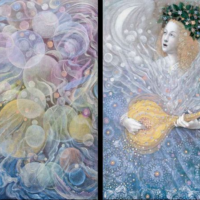Anthroposophy is not about repeating what others have said in the past without investigating it oneself, but about constantly developing new perspectives from personal experience that can be shared and understood by others. This short text looks at some specific features in the development of supersensory organs of perception.
Anthroposophical research is based on the development of soul and spiritual organs of perception. They make it possible to broaden the horizon of experience to include the soul and spiritual dimension of the world and thus establish the possibilities of a spiritual science.
Some Deceptions to Overcome
When we talk about organs of spiritual perception, it is important to dispel some misconceptions that naturally form. Since we are used to perceiving the sensory world, we imagine spiritual perception to be similar to sensory perception. We imagine that a new, “objective” world with properties comparable to those of the sensory world should appear before our spiritual eye. This idea is misleading because spiritual perception is much more subtle than the world of external objects and has completely different characteristics. Although it has an objective character, it arises from the inner activity of the researcher; it is the result of the creative activity of the subject—an activity that can be described as “participatory”. The subject consciously “participates” in its creation.
In contrast, ordinary sensory perceptions are produced by organs that have already been formed so that they appear objective to us from the outset without requiring any special activity on the part of the subject. This difference means that spiritual perceptions, even if they are already present, are easily overlooked and often not recognised as such. This is because there is an expectation that spiritual perceptions will impose themselves like sensory ones. However, these perceptions are of a “subjectively objective” nature and overcome the subject-object separation of ordinary consciousness. They are, we might say, the result of the subject’s participation in the object of their attention and thus unite two sides of reality that are normally separate.
Influenced by the way we experience ordinary sensory perceptions, we also expect spiritual perceptions to be immediately reliable and certain, but this is not the case. The perceptions produced by these organs of the soul and spirit can be misleading, incomplete, or distorted. The level of experience and maturity of the researcher plays an important role here, but no one is immune from mistakes and shortcomings. Also, spiritual perception only provides a certain perspective on a phenomenon, and an error may not lie in the perception itself but in its interpretation. Every researcher must, therefore, be aware that discoveries communicated by other researchers, even if they come from very experienced researchers—such as Rudolf Steiner—must be the subject of further scrutiny to determine the context, perspective, and scope of their validity.
In addition, spiritual perceptions need to be interpreted, conceptualised, and formulated in a comprehensible way. It is quite possible to have perceptions without being able to conceptualise or formulate them. Sometimes, the interpretation is incomplete, while the perception is relevant. In other cases, it is the formulation that becomes difficult. All of this must be taken into account when considering the subject area of the spiritual organs of perception. We would like to focus on this question here, as in our estimation, spiritual perceptions are much more widespread than generally assumed, but not necessarily among those who claim to have such perceptions. Those who have such perceptions do not ordinarily express this openly and formulate their experiences without ascribing special abilities to themselves. Selflessness is a characteristic of genuine spiritual seeking.
Formed in the Light of Universality
There are hundreds of possible ways to describe the formation of the organs of spiritual perception and hundreds of different exercises to do so. Experience shows that some people develop such organs without having read books about them. Careful observation reveals that spiritual perceptions can be present even if the person does not designate them as such. But what, then, is the central process that takes place during the formation of these organs?
In normal life, human consciousness is subject to two unconscious tendencies. In relation to the outer world, the human being tends to create a subject-object split that makes this external world appear “objective”, completely separate from them. This is a tendency towards “non-participation” that is linked to the development of modern scientific consciousness. To the human being, the world around them, in a way, appears alien and fragmented into an infinite number of random events. The other unconscious tendency is found with regard to the inner life. Here, the subject identifies with their experiences, sympathies, antipathies, joys, and sorrows and loses themselves in their inner life and, therefore, cannot perceive it, as they are one with it. This is an excess of “participation”, we might say, a fusion. The processes set in motion by spiritual development change these relationships between the inner and the outer world to then enable “conscious participation”.
The formation of the organs of spiritual perception begins with the experience of the nature of consciousness. This consciousness usually remains the unobserved element of the inner life, as it is the “observer”. The process of thinking takes place in it, which also remains unobserved. This point of consciousness is usually experienced as the subjective part of reality and, therefore, seems to be irrevocably cut off from the world. However, the researcher who investigates the nature of consciousness and its associated thinking activity comes to the conclusion that there is “something” more to be found in consciousness than just pale subjectivity. However, this something, which is latent in ordinary consciousness, normally remains hidden.
Here, the researcher can make a fundamental discovery, a kind of continuation of the Cartesian “cogito”. This discovery has been made by many researchers and formulated in many different ways. “The person who observes thinking lives during this observation in a spiritual, self-supporting web of being. Indeed, we can say that anyone who wants to grasp the essential nature of the spiritual in the form in which it initially presents itself to the human being can do so in the thinking based in itself.” So says Steiner in the Philosophy of Freedom. Here is a different perspective from Schelling: “We all possess a secret, wonderful ability to withdraw from the passage of time into our innermost self, stripped of everything that has been added from outside, and there to behold the eternal within us in immutable form. This perception is the innermost, most intrinsic experience, on which, alone, everything we know and believe about a supersensory world depends.” 1
Diese geistige Erfahrung, das Erwachen des Bewusstseins zu sich selbst, offenbart dem Suchenden, dass innerhalb dessen, was nur Subjektivität zu sein schien, ein Element universeller Natur lebt, das Raum und Zeit übersteigt. Nun geht es nicht nur darum, durch diese innere Erfahrung neue Erkenntnisse über die Natur des Menschen zu gewinnen, sondern auch und vor allem darum, eine neue innere Kraft zu entwickeln. Diese Erfahrung wird zu einer inneren Kraft, wenn sie wiederholt durch Meditation – im weitesten Sinne – kultiviert wird. Sie beginnt dann zu wirken und erleuchtet das innere Leben. So entwickelt der forschende Mensch eine neue Beziehung zu den Bewegungen seines inneren Lebens, mit denen er sich zuvor identifiziert hatte. Er lernt allmählich, sich nicht mehr in den Sympathien, Antipathien und anderen Erlebnissen zu verlieren, die ihn durchdringen, er identifiziert sich nicht mehr mit ihnen, sondern beginnt, sie zu beobachten und sogar durch sie hindurchzusehen. Auf diese Weise nehmen die Bewegungen des inneren Lebens neue Formen an und werden allmählich zu neuen Wahrnehmungsmedien, zu seelisch-geistigen Wahrnehmungsorganen. Die inneren Erlebnisse, die zuvor subjektiver Natur waren, werden allmählich zu Objekten in einem inneren Raum. Das Gedankenleben selbst verändert sich und Ideen beginnen allmählich zu objektiven Realitäten mit einer eigenen kreativen Strahlkraft zu werden. Umgekehrt trifft der umgewandelte Blick nach außen nicht mehr einfach auf Objekte, die von ihm getrennt sind. Die Pflanze, der Stein, das Tier oder der andere Mensch erhält immer mehr den Charakter einer ‹Alterität›, die sowohl tiefer geheimnisvoll als auch vertrauter und intimer wird. Die Welt der Objekte der äußeren Welt erhält immer mehr eine subjektive Qualität, ein inneres Leben.
This spiritual experience, the awakening of consciousness to itself, reveals to the researcher that within what seemed to be nothing but subjectivity lives an element of a universal nature that transcends space and time. It is now not only about gaining new insights into the nature of the human being through this inner experience but also, above all, about developing a new inner force. This experience becomes an inner force when it is repeatedly cultivated through meditation, in the broadest sense. It then begins to take effect and enlightens the inner life of the researcher. In this way, the researcher develops a new relationship to the movements of their inner life with which they had previously identified. They gradually learn to no longer lose themselves in the sympathies, antipathies, and other experiences that pervade them; they no longer identify with them but begin to observe them and even see through them.
In this way, the movements of the inner life take on new forms and gradually turn into new media of perception—soul and spiritual organs of perception. The inner experiences, which were previously of a subjective nature, gradually become objects in an inner space. The life of thoughts itself changes, and ideas gradually begin to become objective realities with their own creative radiance. Conversely, the transformed gaze outwards no longer simply encounters objects that are separate from it. The plant, the stone, the animal or even the other person increasingly takes on the character of an “otherness” that becomes both more deeply mysterious and more familiar and intimate. The world of objects in the outer world takes on more and more of a subjective quality, an inner life.
The nature of the human being is complex, as is humanity as a whole. This process, therefore, takes on complex and diverse forms. The fruits of this new inner activity vary depending on the level of human experience at which they occur: at the level of thinking, language, feelings, external perceptions, impulses of the will, and so on. Every person has their own destiny and their own constitution, which is why the experiences brought about by this inner activity can be very diverse. However, the central spiritual experience, the experience of the universal and divine light in the consciousness, which is cultivated and intensified through meditation, forms an objective foundation that raises subjectivity above itself and becomes a formative force for new organs of perception. The arising of this consciousness in the inner life can also be described as the awakening of the “higher self”. It is its active presence that creates the organs mentioned here in the soul. The following definition of anthroposophy can be understood in this way: “Anthroposophy is cognition that is produced by the higher self in the human being.” 2

The Blossoming of the Human Personality
Through this awakening, a supra-individual element based on inner activity assumes its place within subjectivity. Subjectivity and objectivity combine to form the organs of spiritual perception. These organs and faculties of perception,and the types of cognition associated with them have been described in many different ways in anthroposophical literature, for example, in connection with the “lotus blossoms” or the stages of higher cognition: imagination, inspiration, and intuition. These descriptions are important to form appropriate concepts and to guide the inner work, but they can also be misleading. While ordinary knowledge is essentially a brain activity, spiritual cognition involves the whole person. On the one hand, individual subjectivity is elevated above itself through inner work, but this subjectivity, which also constitutes the uniqueness of each person, is not extinguished. On the contrary, the formation of the spiritual organs of perception does not lead to standardised individuals who perceive, feel, and express the same things. Such formation takes place completely through the original constitution of the individual.
Every person has their own physical, soul, and spiritual constitution, specific talents and weaknesses, a unique biography with particular trials, special research interests, life, and cultural contexts. Spiritual perception and the resulting cognition are formed on this unique basis, which is the building material for these organs. Even if there are universal laws that apply to these processes of organ formation, it is the unique configuration of each individual that gives them their substance. In the field of classic science, individual biography plays a subordinate role, whereas, in the field of spiritual cognition, which involves the whole human being, these factors of biography and destiny play a decisive role. However, this does not mean that such cognition is subjective and unscientific, but that it takes on different forms that are characterised by the individual: how could it be otherwise when we speak of a process of cognition based on freedom and the development of the personality?
Some people have a predisposition which makes them tend to perceive through this or that field of the soul. In addition, the intellectual background of the seeker plays an important role in the way they formulate their perceptions. It makes a difference whether you are an artist, a scientist, or a craftsperson. Besides the languages they speak, everyone has their own language, their own way of expressing themselves, and it can take a long time, sometimes years, to familiarise ourselves with someone else’s way of expressing themselves.
The Other Becomes Ever More Valuable
Although an objectification process takes place in the formation of the spiritual organs of perception, it is also accompanied by a development of the personality, which, to a certain extent, reinforces the differences between individuals. If we are aware of this, we can draw some conclusions from it.
First of all, as in any other field of scientific research, no spiritual research is ever finished and true in itself. It must be constantly re-examined, re-contextualised, and re-explored. A science only becomes a science when it is able to scrutinise itself and continue to develop over time through new research and new researchers.
In addition, spiritual research always expresses the special talents and abilities of a particular person, which makes its contributions all the more interesting and valuable. The further we progress in the field of spiritual research, the more interesting other researchers become, and also other people in general. The more experience we gain, the more we realise that we need others to open up other perspectives, to complement us in areas in which we are less good in our perception, or even to correct misjudgements we may make. Over time, it also becomes clear that the question of spiritual perception and cognition is independent of the words and vocabulary we use for it. For example, some people will never admit that they already have spiritual perceptions, even though this is the case. They do not put these words on their experiences. Spiritual perception often takes subtle forms that go unnoticed but are nevertheless significant and decisive. Nor does a person have to be an “anthroposophist” in the outer sense of the word to have begun to awaken the “higher self” and the organs associated with it. It is, therefore, clear that all conceivable situations can occur.

So, the development of spiritual cognition in no way has a “standardising” or “normative” effect but rather increases human diversity and the intensity of such diversity, thus making it increasingly interesting and worthwhile despite all the difficulties involved. On the one hand, this research work must take place in the laboratory of the inner life, but on the other hand it also requires the laboratory of encounter, exchange and work with others. These encounters will show how much a new art of conversation needs to be developed, a kind of resurrection of Socratic maieutics that allows everyone to express themselves, to formulate their inner experiences, and to be understood by others in order to make progress in constructive dialogues that respect the diversity of personalities.
This wealth of abilities forms the raw material for the life of anthroposophy. The appreciation of this wealth is certainly a central task of the School of Spiritual Science and the Anthroposophical Society, which will celebrate the centenary of their re-founding at Christmas 2023. Together, they form a melting pot for human encounter and exchange, a space for practice, and an arena for formulating and publishing the fruits of this participatory spiritual research. When we become aware of the diversity and the many nuances in which spiritual research reveals itself, we develop a boundless interest in other researchers and sense how valuable each person is in their uniqueness.
Translation Christian von Arnim
Sketches Fabian Roschka
Footnotes
- Friedrich Schelling, “Briefe über Dogmatismus und Kritizismus” [”Letters about dogmatism and critisicm”], 8th Letter, (Independently published, 2019).
- Rudolf Steiner’s suggestion of a definition for the word “anthroposophy” for the Oxford Dictionary: “Anthroposophy is a knowledge produced by the Higher Self in man.”, in Carl Unger, Was ist Anthroposophie? (Verlag am Goetheanum, 1996).









